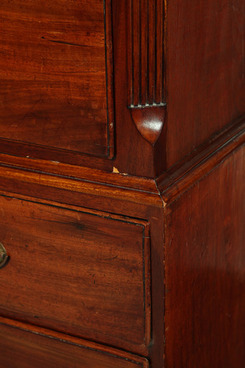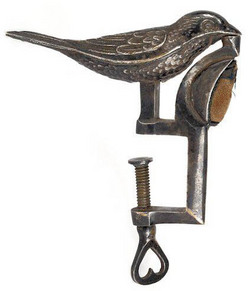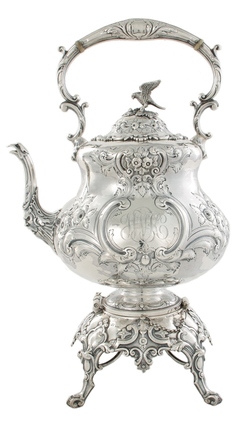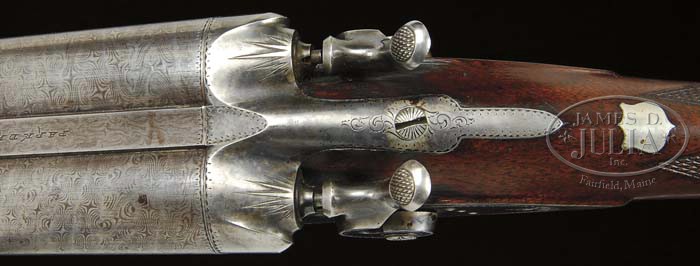 Chamfer is derived from a French word that means exactly what it means in the current usage: a beveled edge. In terms of furniture, a chamfer is a shaped edge where two pieces of wood meet. A chamfered edge refers to what is typically a 45-degree cut on a corner, which results in a softening of the corner. When a corner is softened with a “convex” rounded edge, it’s referred to as a bullnose. Oftentimes in furniture with exterior chamfering on the corners, the cut tapers out at the ends, which is called a variety of things including lamb’s tongue or lark’s tongue. (Some distinguish a lamb’s tongue from a lark’s tongue by using lark’s tongue for a plain, smooth tapered end and lamb’s tongue for tapering that includes a bit of a step and curl at the end.) Exterior chamfers are also sometimes decorated with reeded carving, like the one pictured above. Chamfering on the interior of a piece tends to refer to rough shaping on the panels in doors to taper the panels down to fit the joint. This sort of chamfering also appears on other unseen places including drawer bottoms and case backs. Chamfering, particularly interior chamfering with a hand plane, is one of the most obvious indicators that a piece was handmade instead of mass produced.
Chamfer is derived from a French word that means exactly what it means in the current usage: a beveled edge. In terms of furniture, a chamfer is a shaped edge where two pieces of wood meet. A chamfered edge refers to what is typically a 45-degree cut on a corner, which results in a softening of the corner. When a corner is softened with a “convex” rounded edge, it’s referred to as a bullnose. Oftentimes in furniture with exterior chamfering on the corners, the cut tapers out at the ends, which is called a variety of things including lamb’s tongue or lark’s tongue. (Some distinguish a lamb’s tongue from a lark’s tongue by using lark’s tongue for a plain, smooth tapered end and lamb’s tongue for tapering that includes a bit of a step and curl at the end.) Exterior chamfers are also sometimes decorated with reeded carving, like the one pictured above. Chamfering on the interior of a piece tends to refer to rough shaping on the panels in doors to taper the panels down to fit the joint. This sort of chamfering also appears on other unseen places including drawer bottoms and case backs. Chamfering, particularly interior chamfering with a hand plane, is one of the most obvious indicators that a piece was handmade instead of mass produced.
 Few people sew these days and the majority of those who do use a vast area of expensive equipment and gadgetry, but “sewing notions,” as they’re often called, are nothing new. Take, for instance, the sewing bird. In the days before things like quilting hoops and dressmaker dummies (or at least affordable ones), a woman stitching would use a sewing bird to clamp her work to the edge of a table top, keeping a steady tension as she worked on a seam. A sewing bird is simply a clamp, made of everything from brass to wood, embossed tin to bone, cast iron to wrought iron, typically with a figural top in the form of a bird. Sewing clamps dating back to the 16th and 17th centuries have been discovered, but their heyday was the 19th century, when sewing birds in particular were popular. Initially they were a screw-type clamp, but later models sometimes employed springs. They occasionally appear in other forms – frogs, dolphins – but perhaps birds were the most common because when in use it appeared as though the bird was “perched” on the table. And, since the sewing bird was just sitting right there, the form was soon embellished, often appearing with a small pincushion.
Few people sew these days and the majority of those who do use a vast area of expensive equipment and gadgetry, but “sewing notions,” as they’re often called, are nothing new. Take, for instance, the sewing bird. In the days before things like quilting hoops and dressmaker dummies (or at least affordable ones), a woman stitching would use a sewing bird to clamp her work to the edge of a table top, keeping a steady tension as she worked on a seam. A sewing bird is simply a clamp, made of everything from brass to wood, embossed tin to bone, cast iron to wrought iron, typically with a figural top in the form of a bird. Sewing clamps dating back to the 16th and 17th centuries have been discovered, but their heyday was the 19th century, when sewing birds in particular were popular. Initially they were a screw-type clamp, but later models sometimes employed springs. They occasionally appear in other forms – frogs, dolphins – but perhaps birds were the most common because when in use it appeared as though the bird was “perched” on the table. And, since the sewing bird was just sitting right there, the form was soon embellished, often appearing with a small pincushion.
As sewing birds go at auction, value seems to be “clamped” to a couple factors, aside from the usual caveats about age and condition (the spring models in particular are often damaged): materials and form. Bird forms make up the vast majority of those that appear at auction, so rarer forms can command bigger prices and standard mass-manufactured versions from cast iron or brass have far less value than those made from rare more “individualized” handcraft materials such as wrought iron, wood and bone.
 This week, it’s two for one! Malleable metals – copper, gold, silver, for example – primarily exhibit two essentially opposite techniques of shaping: repoussé and chasing. Repousse, a French word which means “pushed up,” is accomplished by hammering the back side of the sheet of metal to “push up” a design in relief. Chasing, also from French – chasser meaning to drive out or chase around – is simply the opposite: pressure applied to the front of an object to create a design by lowering portions of the metal below the surface. Most objects have both repousse and chasing (like the Martin & Hall Victorian sterling silver kettle on stand pictured here) as well as the third primary method of metal decoration, engraving.
This week, it’s two for one! Malleable metals – copper, gold, silver, for example – primarily exhibit two essentially opposite techniques of shaping: repoussé and chasing. Repousse, a French word which means “pushed up,” is accomplished by hammering the back side of the sheet of metal to “push up” a design in relief. Chasing, also from French – chasser meaning to drive out or chase around – is simply the opposite: pressure applied to the front of an object to create a design by lowering portions of the metal below the surface. Most objects have both repousse and chasing (like the Martin & Hall Victorian sterling silver kettle on stand pictured here) as well as the third primary method of metal decoration, engraving.
There are a variety of techniques for accomplishing repousse and chasing, but traditionally, the work was done with the aid of pitch or resin. The object would be placed on or, in the case of hollowware, surrounded by (or in the case of chasing, filled with), pitch, which would help soften and regulate the impact of any force applied by hammering. Then the pitch would be removed, the work would be reviewed and adjusted if necessary, and the pitch would be applied again for subsequent workings. Despite the time-consuming nature of the work, repousse and chasing are very cost-effective, as no metal is actually removed.
Traditionally, this was done with the aid of pitch or resin. The object would be placed on or, in the case of hollowware, surrounded by (or in the case of chasing, filled with), pitch, which would help soften and regulate the impact of any force applied by hammering. Then the pitch would be removed, the work would be reviewed and adjusted if necessary, and the pitch would be applied again for subsequent workings. Despite the time-consuming nature of the work, repousse is very cost-effective, as no metal is actually removed.
 Damascus steel is yet another example of a term’s original definition becoming almost inextricably conflated with a different concept. Damascus steel, used historically in blades manufactured in Middle East, is also a bit of a mystery. The process, as best we can tell, started with wootz steel, a type of steel which appears to have originated in India approximately 300 years B.C. Beyond that, we have no idea how it was originally crafted. The origin of the name Damascus itself is a bit of a puzzle, as it is also unknown if it was first used for swords made or sold in Damascus or if it was applied based on a perceived connection between the appearance of the steel and Damask cloth, which also derives its name from Damascus.
Damascus steel is yet another example of a term’s original definition becoming almost inextricably conflated with a different concept. Damascus steel, used historically in blades manufactured in Middle East, is also a bit of a mystery. The process, as best we can tell, started with wootz steel, a type of steel which appears to have originated in India approximately 300 years B.C. Beyond that, we have no idea how it was originally crafted. The origin of the name Damascus itself is a bit of a puzzle, as it is also unknown if it was first used for swords made or sold in Damascus or if it was applied based on a perceived connection between the appearance of the steel and Damask cloth, which also derives its name from Damascus.
Perhaps it is this mystery or the distinctive appearance of Damascus steel, which is said to look like flowing water or watered silk because of the banded look of the surface, but Damascus steel has a reputation filled with legends about its sharpness and durability. Many tests have been performed on original examples of Damascus steel, but because there are so many variables in the production process – raw materials, techniques, equipment – efforts to replicate the steel have failed. True Damascus steel production seems to have stopped around the middle of the 18th century for reasons lost to us now, but historians offer a number of hypotheses, including the possibility of a trade route disruption (such a lengthy route, India to the Middle East, could have quite possibly have been disturbed long enough and to such an extent that the technique was lost in the interim), a change in the manufacturing process that removed the necessary impurities, or simply an obsessive degree of secrecy regarding the tricks of production.
Regardless of the reasons, pattern welded steel blades offer the closest replication, at least in terms of appearance. Pattern welding, which is similar to laminating steel and has been done since the Middle Ages, is accomplished by forge welding a group of different metals together and then twisting and manipulating them to create the appearance of a patterned surface. Blades and barrels formed by this technique (or from laminated or piled steel) are also often referred to as Damascus, even though the production process is completely different. Historians attributed this to bladesmith William Moran, who debuted his “Damascus knives” in 1973. Early on, there appears to have been some distinction in the use of the term “Modern Damascus,” but for the most part, weapons, historic and modern, with barrels and blades forged by pattern welding are also simply referred to as Damascus.
Meanwhile, experts in the field of experimental archaeology continue to try to unravel the secrets of Damascus steel production. As for us, true Damascus steel is rare enough that, with the additional restriction of adequate detail photographs, the picture above shows pattern welded steel, although you can see an cannon with a Damascus barrel here.
![Thomas Clarkson Oliver, called Clark Oliver (American, 1827 to 1893) oil on artist board [marine] painting, Two Ships in a Storm, en grisaille, signed and dated "Clark Oliver 1889" in pencil lower right](http://www.prices4antiques.com/item_images/medium/67/74/08-01.jpg) Grisaille, from the French word gris meaning grey, is a term used to describe works of art painted entirely in a monochromatic palette. Technically speaking, there are other terms that apply when the monochromatic palette used is of a different color (brunaille for brown, verdaille for green, for instance), but grisaille is often misused to cover all monochrome works, regardless of hue. There are also plenty of works that are considered grisaille that are not perfectly, strictly speaking, in just one color, but the palette is severely curtailed.
Grisaille, from the French word gris meaning grey, is a term used to describe works of art painted entirely in a monochromatic palette. Technically speaking, there are other terms that apply when the monochromatic palette used is of a different color (brunaille for brown, verdaille for green, for instance), but grisaille is often misused to cover all monochrome works, regardless of hue. There are also plenty of works that are considered grisaille that are not perfectly, strictly speaking, in just one color, but the palette is severely curtailed.
Works “en grisaille” as they are usually referred to can be done as finished works, but they are also used to mimic the three-dimensional effect of sculpture in a tromp l’oeil style, to provide a basis for adaptation by engravers or illustrators, or to “rough in” an oil painting’s structure.
In the world of antiques, grisaille is often seen in connection with the decoration on Chinese export porcelain (sometimes the entire work is decorated en grisaille, sometimes only a portion), and the value there is derived from age and condition, but works executed completely en grisaille do frequently see a bump in value. In terms of fine art, the highest prices are reserved for early artists like Van Dyck who were known for their use of the technique, but grisaille works are, in general, popular and appealing because it’s generally conceded that working with a full palette can hide some weakness in skill and execution, whereas such a limited palette requires a more skillful hand.



